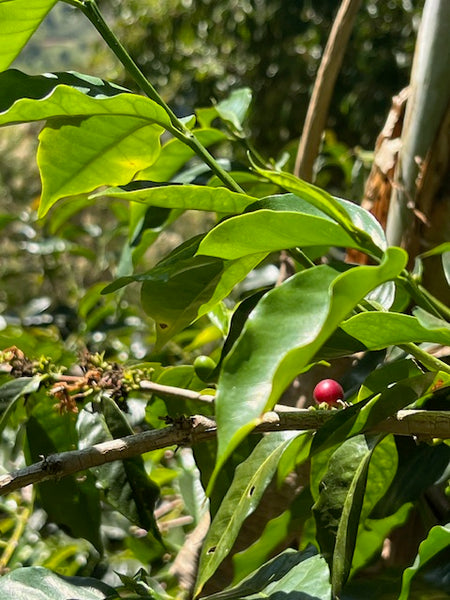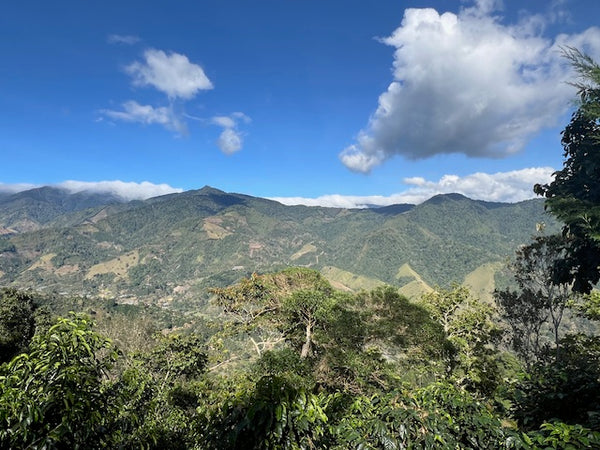2024 Costa Rica Trip Recap: Pura Vida at its Best!
It’s not every day you get to go on a trip that truly changes your perspective, or at least adds to it in a way that significantly changes how you view your job and a beverage you drink daily.
Coffee has been my true love for years, but visiting a coffee-growing country was so far outside the realm of possibilities in my mind that I’d never even dreamed of going. And then I started working at Carabello Coffee. Knowing that Carabello values creating opportunities for employees to go on such trips, a hope sprung up that I’d get to go on one. Just after hitting my one year anniversary as a Carabello employee, I was given the opportunity to go on my first trip to coffee origin in Costa Rica!
It’s hard to capture such an impactful experience in words—I’m far better at telling a story out loud with lots of hand gestures—but I’ll try to highlight what stood out to me while pulling in some thoughts from Justin, Emily, and Anna.
- - -
After an extremely long day of travel to get to the Ureña farm on Tuesday, February 13, we woke up on Wednesday ready to explore the beautiful mountains and see some coffee growing. We all piled into a jeep with tractor-like wheels, held on, and started our bumpy ride up the mountain.
It’s so interesting how you can see pictures of how coffee is grown and processed, but until you’re traveling up a steep, rocky mountainside in a jeep with tractor-like wheels…you don’t fully get it.

We stopped to explore coffee plants on the side of the mountain and I had two main thoughts: “Wow, this is so high and steep” and “Wow, this is so beautiful.” We walked down into some growing coffee and banana plants and fruit trees and it was difficult to keep our footing due to the steep grade—we marveled at the challenge it must be for the coffee pickers to pick these cherries by hand on such an incline, as well as carry full loads of cherries down the mountain.



While standing within the coffee plants, Mario—the second oldest Ureña brother—handed me a coffee cherry to eat. Now, I’ve seen the diagrams of the layers of a coffee cherry so I fully know that coffee beans are the seeds inside, but the moment I popped one in my mouth, my brain forgot that I wasn’t just eating a normal cherry. “There’s a pit in here!” I thought, instinctively spitting it into my hand. My brain exploded as I looked down, incredulous, at the two mucilage-covered coffee beans resting on my palm. “Wow…it’s coffee!” That is the moment it hit me how crazy it is that these little seeds growing high up on a mountain miraculously make it into my cup every day.


When processing the trip later, my coworker Anna—full-time nurse and part-time barista—said that the most eye-opening thing about the trip was actually seeing how much effort it is to get coffee down the mountain, processed, and roasted up and into our cups. I agree wholeheartedly. It gave us both an appreciation for the long journey a coffee bean takes from seed to cup.

After our initial trip up the mountain, we had lunch in the home of Ricardo—the oldest Ureña brother—and his wife Tatiana, along with their little girls Sara and Lucianna. This was the first of several meals and snacks in and around the Ureña family’s homes and these times highlight what I loved most about this trip.
The whole family lives on the same plot of land, in different houses. When Mario would drive us around, he’d often wave to whoever we passed and it became the joke between us that every one of them was a cousin—because many of them were! This is so different from what I’m used to here in the U.S., but I loved that even an afternoon snack on the farm could involve the whole family.

The afternoon of that first day was special as it happened to be Ash Wednesday, so we went to mass with Ricardo and his family—this experience was a highlight as it was a way we were able to connect outside of coffee. This is what Justin Carabello and I both loved the most about this trip: how coffee is a relational beverage, a connector that brings people together.

When reflecting on the trip, Justin said:
“For me, so much of what fuels my passion for and love of coffee is that we can establish these types of relationships with producers and their families in different parts of the world. Cooking and eating meals with the Urenas, going to mass with them on Ash Wednesday, trying to communicate with Regulo and Isabella knowing very little Spanish…that’s really significant for me. Money can’t buy experiences like these. I want to be able to represent the hard work and passion of these people not just as a roaster but as their friend. I want to know them and not just have a business relationship. It takes time to form these relationships, but this trip was such a good step towards deepening that.”
Later that day, Ricardo gave us a tour of the coffee processing, showing us the raised beds, a mechanical dryer, and other methods of sorting out the best coffee. Again, it was amazing to see in real life what I’ve often seen in pictures—to get to walk through drying coffee cherries and pick them up with my hands.


That night we had dinner with Regulo—whose face is on our blue label bags—and his wife Isabella. Emily and Justin had a great time helping them cook our meal. They also don’t speak much English, so it was really fun communicating with them…and we made it work!

Moments like this were also a highlight for Emily. It had been four years since she’d been to coffee origin as she kept giving up her spot to employees. Emily said:
“Due to COVID we got backlogged on sending employees and had many to catch up on this past couple years. So it was really great getting back! I really enjoyed meeting the Urena family and getting a first hand look at their lives—meeting all kinds of people is one of my favorite things about working in the coffee industry. Such a good reminder that what we do impacts people all over the world, and is bigger than just this little corner of Kentucky.”
The next day—Thursday—we cupped coffees, had more family meals, traveled up another mountainside with Ricardo (where we got out of the jeep and did some hiking), and met some coffee people from Denmark.


I wish I could go into all the details of what we experienced before heading back down for a day in San Jose on Friday, but based on the length of this blog, I’d probably have to write a book to really paint a picture for you.
So I’ll just leave you with my final thought:
It’s always hard for me to leave a place once I feel like I have friends there and it always surprises me how you don’t need much time to create a connection when you are open to learning about and sharing with others. Just a little over two days with the Ureña family was long enough for me to feel like they are friends and that’s what made this trip such an amazing experience. All made possible by a little energetic cherry seed we all love.

